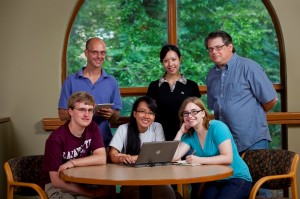
Clockwise from left are Christopher Jones ’13, Professor Chris Ruebeck, Laura Wong Hon Chan ’12, Professor Jeff Pfaffmann, Shannon Sullivan ’13, and Phuong Anh Nguyen ’12.
Several Lafayette students worked this summer on an ongoing, interdisciplinary project that combines aspects of economics, computer science, and engineering to enhance environmental policymaking. The team focused its research on using computational models to simulate the life cycles of shipping pallets, cell phone batteries, and water systems.
Although most of the students who were involved this summer are majoring in something other than computer science, they all brought computing experience to the project, the result of the College’s emphasis on students learning computational methods.
Since September 2007, the project has been funded with a three-year, $635,000 grant from the National Science Foundation. The work is led by Sharon Jones, professor of civil and environmental engineering and director of engineering; Jeff Pfaffmann, assistant professor of computer science; Chris Ruebeck, associate professor of economics; and Kristen Sanford-Bernhardt, assistant professor of civil and environmental engineering.
The research is built on a decision-making model, developed by Ruebeck and Jones, that combines economic incentives with environmental data. Using computer simulations running on advanced parallel-processing computing equipment, the team of faculty and student researchers continuously improves the model and uses it to test case studies.
“Because the students are doing some of the programming, they get to see what happens when a model becomes complex as well as when it doesn’t capture some important feature of reality,” says Ruebeck. “This is important for students interested in economics even if they don’t go on to use their computer programming skills, and it is important for advanced computer science students for the same reason: We have to think about the consequences of our modeling decisions.”
Shannon Sullivan ’13 (Short Hills, N.J.), a psychology major, worked on coding the model being used to study water systems. “This project has given me a lot of experience with programming beyond what is done in an ordinary lab during school. Because of this, I’ve learned how to analyze code better, my problem-solving skills have improved amazingly, and I’ve become a more independent thinker,” she says.
Computer science major Christopher Jones ’13 (Macungie, Pa.) got the chance to stretch his computing skills. His role was to work on building a scheduling system for running various types of models. A version of the scheduling system was in place before Jones started working on it this summer.
“I now know what it is like coming into a project that has already begun and learning to understand and integrate the existing code into your new code. I also have worked on a large coding project that I can put on my resume,” says Jones, who would like to pursue a career as a software designer.
Phuong Anh Nguyen ’12 (Ho Chi Minh, Vietnam), an international economics and commerce major, explored the behavior of the model for general systems and incorporated that information into the simulations she was running. Nguyen says that the project has given her the opportunity to learn programming languages other than those she acquires in the classroom, and to use skills that fall outside her major.
“This project is highly interdisciplinary and therefore has exposed me to diverse observation angles. When I scrutinize the behavior of the model or analyze why the model is not working the way it should, I have to think as an economist. When I actually sit down and program the code, I have to think as a computer scientist. When I step back and look overall at the project, it is amazing how I can apply classroom knowledge into a real-world problem and truly understand that theory and reality are indeed closely connected. I really enjoy this logical and practical thinking process,” Nguyen says.
Laura Wong Hon Chan ’12 (Tombeau Bay, Mauritius), an economics major, investigated the Lehigh Valley grocery supply chain in order to apply the general model of shipping pallet flow to a particular case study. She programmed Geographic Information Systems functionality in the simulation model to place those pallet users geographically in the Lehigh Valley.
Students and faculty have presented the research at numerous conferences, including the American Society of Engineering Education, the 2010 conference on Computation in Economics and Finance in London, the Eastern Economics Association, the 2010 International Industrial Organization Conference, the 2008 National Science Foundation-Human Social Dynamics grantees conference, the Western Economic Association, and the 2010 Workshop on Dynamic Control, Dynamic Games, and Nonlinear Dynamics in Amsterdam.
